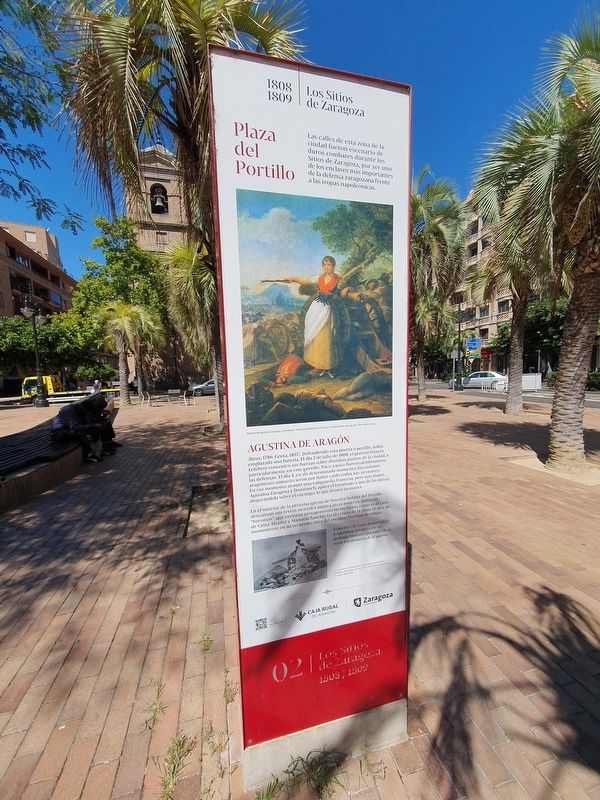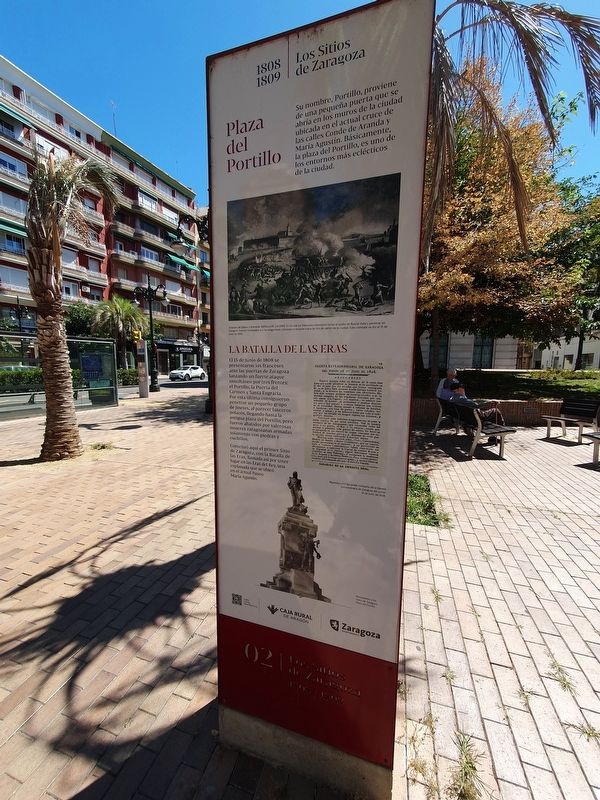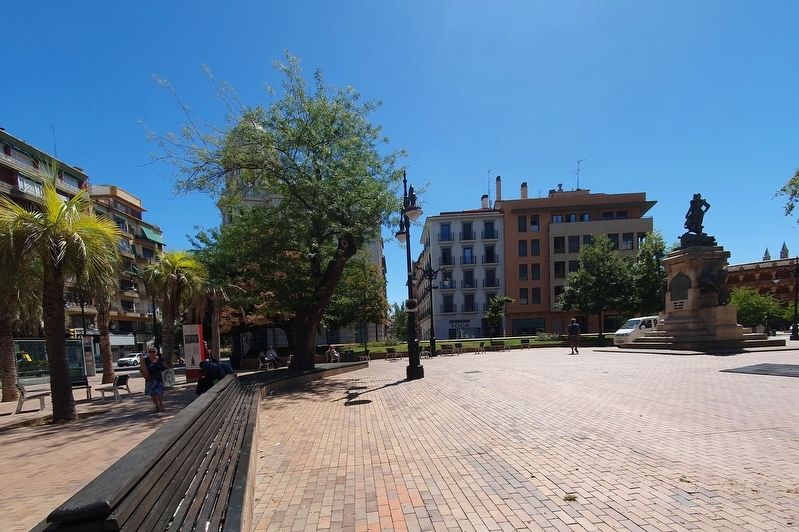El Gancho in Zaragoza, Aragón, Spain — Southwestern Europe (Iberian Peninsula)
Plaza del Portillo
1808 · 1809 · Los Sitios de Zaragoza
Las calles de esta zona de la ciudad fueron escenario de duros combates durante los Sitios de Zaragoza, por ser uno de los enclaves más importantes de la defensa zaragozana frente a las tropas napoleónicas.
Agustina de Aragón
(Reus, 1786-Ceuta, 1857). Defendiendo esta puerta o portillo, había emplazada una batería. El día 2 de julio de 1808, el general francés Lefebvre concentró sus fuerzas sobre distintos puntos de la ciudad, y particularmente en este portillo. Poco a poco fueron debilitándose las defensas. El día 4, en un determinado momento, los cañones aragoneses enmudecieron por haber caído todos sus sirvientes. En ese momento avanzó una vanguardia francesa, pero una mujer, Agustina Zaragoza y Doménech, aplicó el botafuego a una de las piezas, disparándola sobre el enemigo, lo que detuvo su avance. En el interior de la próxima iglesia de Nuestra Señora del Portillo descansan sus restos mortales junto a otras mujeres, llamadas “heroínas”, que tuvieron protagonismo en los Sitios, como es el caso de Casta Álvarez y Manuela Sancho. En el centro de la plaza se alza un monumento en su recuerdo, obra del escultor Mariano Benlliure. Francisco de Goya inmortalizó a Agustina Zaragoza en un grabado titulado Qué valor, de la serie Los desastres de la guerra.
Plaza del Portillo
Su nombre, Portillo, proviene de una pequeña puerta que se abría en los muros de la ciudad ubicada en el actual cruce de las calles Conde de Aranda y María Agustín. Básicamente, la plaza del Portillo, es uno de los entornos más eclécticos de la ciudad.
La Batalla de las Eras
El 15 de junio de 1808 se presentaron los franceses ante las puertas de Zaragoza lanzando un fuerte ataque simultáneo por tres frentes: el Portillo, la Puerta del Carmen y Santa Engracia. Por esta última consiguieron penetrar un pequeño grupo de jinetes, al parecer lanceros polacos, llegando hasta la antigua plaza del Portillo, pero fueron abatidos por valerosas mujeres zaragozanas armadas solamente con piedras y cuchillos. Comenzó aquí el primer Sitio de Zaragoza, con la Batalla de las Eras, llamada así por tener lugar en las Eras del Rey, una explanada que se ubicó en el actual Paseo María Agustín.
Pie de dibujos
Retrato de Agustina Zaragoza y Domènech. Fernando Brambila y Ferrari (a). Primera mitad del siglo XIX. Óleo sobre lienzo.
Los desastres de la guerra consta de una serie de 82 grabados realizados por el pintor Francisco de Goya entre los años 1810 y 1815.
Grabado de Gálvez y Brambila: Batalla de las Eras. En la cual los franceses intentaron forzar el punto de Buena Vista y penetrar en Zaragoza. Fueron rechazados por los aragoneses y forzados a situarse fuera de tiro de cañón de la ciudad. Este combate se dio el 15 de junio de 1808.
Reproducción facsimilar completa de la Gaceta Extraordinaria de Zaragoza del jueves 16 de junio de 1808.
Monumento a los Sitios de Zaragoza. Plaza del Portillo.
Portillo Square
The streets in this city area were the scene of intense battles during the Sieges of Zaragoza since it was one of the most important sites of Zaragoza’s defence against the Napoleonic troops.
Agustina of Aragón
(Reus, 1786-Ceuta, 1857). An artillery battery had been placed to defend the Portillo gate. On 2 July 1808, the French General Lefebvre amassed his forces at different points of the city and specifically at that gateway. The defences were gradually weakened little by little. At a certain time on 4 July, the Aragon cannons fell silent because all the gunners had fallen. At that moment, a French vanguard unit advanced, however a woman, Agustina Zaragoza y Doménech lit the fuse of one of the cannons, firing it at the enemy which halted their attack.
Inside the nearby Church of Nuestra Señora del Portillo, her mortal remains rest alongside other women who were called “heroines” who played major roles in the Sieges, as is the case of Casta Álvarez and Manuela Sancho. A monument in her memory has been built in the centre of the square, with artwork by the sculptor, Mariano Benlliure.
Francisco de Goya immortalized Agustina Zaragoza in his engraving titled Qué valor (What bravery), in his series: Los desastres de la guerra (The disasters of war).
Portillo Square
Its name, “Portillo”, originates from a small gateway which was opened in the city walls, located in the present day junction of the streets: Calle Conde de Aranda and Calle María Agustín. The square called Plaza del Portillo is basically one of the most eclectic environments of the city.
The Battle of the Eras
On 15 June 1808, French troops appeared before the gates of Zaragoza in a strong simultaneous attack on three fronts: the Portillo gate, the Carmen gate and the Santa Engracia gate. At the latter, a small group of cavalry, apparently Polish Guard Lancers, penetrated and arrived at the old square: Plaza del Portillo, but they were killed by brave Zaragoza women who were only armed with rocks and knives.
The first Siege of Zaragoza began here with the Battle of Las Eras, which was named because it took place at the esplanade called “Eras del Rey”, (“Threshing grounds of the King”) located in the present day Promenade called Paseo María Agustín.
Captions
Portrait of Agustina Zaragoza y Domènech (1785-1885). Fernando Brambila y Ferrari (a). First half of the 19th century. Oil on canvass.
The “Disasters of War” consists of a series of 82 engravings made by the painter Francisco de Goya between the 1810 and 1815.
Engraving by Gálvez y Brambila. The Battle of the Eras. In this battle, the French tried to force entry at the Buena Vista point and invade Zaragoza. They were repelled by the Aragon defenders and forced to retreat from the city’s cannon fire. This combat took place on 15 June 1808.
Reproducción facsimilar completa de la Gaceta Extraordinaria de Zaragoza del jueves 16 de junio de 1808.
Monumento a los Sitios de Zaragoza. Plaza del Portillo.
Erected by Ayuntamiento de Zaragoza. (Marker Number 2.)
Topics. This historical marker is listed in these topic lists: Wars, Non-US • Women. A significant historical year for this entry is 1808.
Location. 41° 39.346′ N, 0° 53.539′ W. Marker is in Zaragoza, Aragón. It is in El Gancho. Marker is on Calle del Conde de Aranda east of Plaza del Portillo, on the right when traveling east. Touch for map. Marker is in this post office area: Zaragoza, Aragón 50004, Spain. Touch for directions.
Other nearby markers. At least 8 other markers are within walking distance of this marker. Plaza del Portillo Monumento a los Sitios de Zaragoza (a few steps from this marker); Iglesia de Nuestra Señora del Portillo (within shouting distance of this marker); Palacio de la Aljafería (approx. 0.3 kilometers away); La Aljafería (approx. 0.3 kilometers away); Calle Ramón Pignatelli, 67 (approx. 0.4 kilometers away); Calle Ramón Pignatelli, 65 (approx. 0.4 kilometers away); Calle Ramón Pignatelli, 63 (approx. 0.4 kilometers away); Calle Ramón Pignatelli, 70 (approx. 0.4 kilometers away). Touch for a list and map of all markers in Zaragoza.
Also see . . . Plaza del Portillo. The Ayuntamiento de Zaragoza maintains this website with Spanish, English and French versions of the markers in this series on the Sieges of Zaragoza in 1808 and 1809. (Submitted on December 3, 2023.)
Credits. This page was last revised on December 3, 2023. It was originally submitted on December 1, 2023, by J. Makali Bruton of Accra, Ghana. This page has been viewed 44 times since then and 14 times this year. Photos: 1, 2. submitted on December 1, 2023, by J. Makali Bruton of Accra, Ghana. 3. submitted on December 3, 2023, by J. Makali Bruton of Accra, Ghana.


